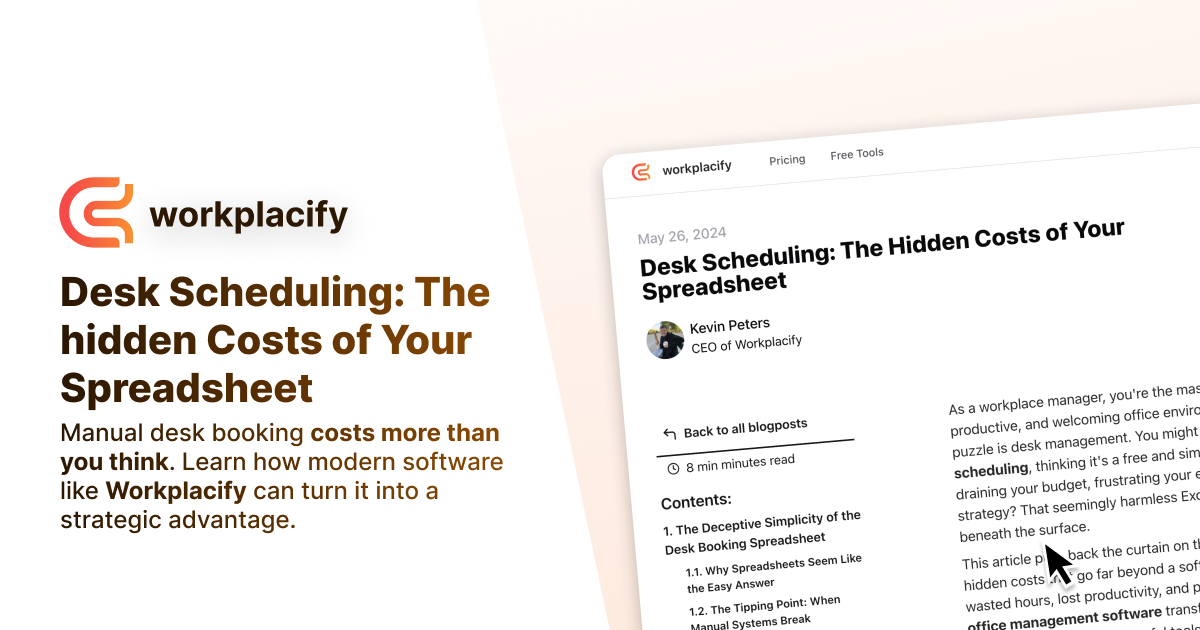workplacify
Create professional hybrid workplace policies
Calculate potential savings from optimizing desk usage
Create professional visitor badges with QR codes
August 20, 2025
Desk Scheduling: The Hidden Costs of Your Spreadsheet

Kevin Peters
CEO of Workplacify

As a workplace manager, you're the master of a complex puzzle: creating an efficient, productive, and welcoming office environment. In the hybrid work era, a core piece of that puzzle is desk management. You might be using a shared spreadsheet for your desk scheduling, thinking it's a free and simple solution. But what if that "free" tool is secretly draining your budget, frustrating your employees, and undermining your entire workspace strategy? That seemingly harmless Excel or Google Sheet is an iceberg. Its true cost lies beneath the surface.
This article pulls back the curtain on the real price of manual desk booking. We'll dissect the hidden costs that go far beyond a software subscription fee, including expenses measured in wasted hours, lost productivity, and poor strategic decisions. We will explore how modern office management software transforms this operational headache into a strategic advantage, leveraging powerful tools like office analytics and dynamic floor planning. By the end, you'll understand why moving beyond the spreadsheet isn't just an upgrade; it's a critical investment in your company's future.
The Deceptive Simplicity of the Desk Booking Spreadsheet
At first glance, a spreadsheet feels like the path of least resistance. It's familiar, accessible to everyone, and seems to cost nothing. This initial simplicity is precisely why so many organizations default to it, especially when first dipping their toes into hybrid work or hot desking.
Ready to Ditch the Spreadsheet?
Stop wasting hours on manual desk booking. See how a dedicated platform provides real-time data and a seamless employee experience.
Why Spreadsheets Seem Like the Easy Answer
For a small team with a handful of desks, a spreadsheet can function passably. The logic is straightforward: create a grid with dates and desk numbers, share the link, and ask employees to fill in their names. There are no new platforms to learn, no procurement processes to navigate, and no budget lines to justify. It's the quintessential DIY solution. You, the workplace manager, can set it up in an afternoon, and it feels like you've solved the desk scheduling problem.
This approach often works during a trial period or when a hybrid model is informal. Employees are generally adaptable, and the occasional hiccup, like someone forgetting to update the sheet or accidentally deleting a row, is manageable. The perceived lack of direct cost makes it an easy sell to leadership, who are often focused on minimizing overhead. It's a classic case of "if it ain't broke, don't fix it." The problem is that it's quietly breaking in ways that aren't immediately obvious.
The Tipping Point: When Manual Systems Break
Every organization using a spreadsheet for desk scheduling has a tipping point. This is the moment the system's flaws cascade from minor annoyances into significant operational failures. This tipping point is often triggered by growth, a more formalized hybrid policy, or an increase in the number of employees returning to the office.
Suddenly, the single point of failure becomes glaring. The spreadsheet crashes or becomes painfully slow with too many users. Conflicts and double bookings become a daily occurrence, not a rare exception. Your inbox floods with messages like, "Who booked Desk 7? It's not on the sheet," or "Can you help me find a spot near my team?" You transition from a strategic workplace manager into a full-time desk referee. The system that was meant to be simple now consumes hours of your week, creating friction and frustration for the very people it's supposed to help. This is where the hidden costs of manual desk booking begin to surface, revealing that the "free" solution was never truly free at all.

Uncovering the Hidden Costs: Beyond the Bottom Line
The true cost of a desk booking spreadsheet isn't a line item in your budget; it's paid for in time, productivity, and morale. These intangible expenses accumulate daily, creating a significant drag onworkspace efficiency/productivity and ultimately impacting the company's financial health.
The Time Tax: Your Admin's Most Wasted Resource
Think about the time you or your administrative staff spend managing the spreadsheet. This includes several key tasks:
Manually resolving conflicts: Investigating and mediating double bookings.
Fielding requests: Answering constant questions about availability or desk locations.
Enforcing rules: Chasing down employees who haven't signed up or who are "squatting" at unbooked desks.
Maintaining the sheet: Fixing broken formulas, accidental deletions, and ensuring the template is clean for the next week or month.
If you spend just 30 minutes a day on these tasks, that's 2.5 hours a week, or over 120 hours a year. Now, multiply that by your hourly rate. Suddenly, the "free" spreadsheet has an annual cost in the thousands of dollars, just in your time alone. This "time tax" prevents you from focusing on higher-value strategic initiatives, like improving the overall workplace experience or analyzing space utilization for long-term planning. It traps you in a reactive, administrative cycle.
The Strategic Blind Spot: Spreadsheets Offer Zero Insight
Perhaps the most significant cost of a desk booking spreadsheet is the one you can't see: the complete lack of data. In an age where businesses rely on analytics to drive every decision, managing your most expensive asset, your real estate, with zero visibility is a strategic blunder.
Flying Blind on Workspace Utilization
Your spreadsheet might tell you who said they were coming in, but it can't tell you what actually happened:
Did they show up?
How long did they stay?
Which desks are most popular and why? (e.g., near a window, in a quiet zone)
Which areas of the office are consistently empty?
Without this information, you are flying blind. You can't improve office space utilization because you don't have a baseline. You might be paying for three floors of office space when real-world usage patterns show you only need two. Conversely, you might be forcing teams into a space that is too small, creating overcrowding on peak days and hindering collaboration.
Why 'Office Analytics' is Impossible with Excel
True office analytics provides actionable insights. A dedicated office management software collects data automatically via check-ins, sensors, or integrations, and presents it in an easy-to-understand dashboard. You can instantly see:
Peak occupancy rates: Identify your busiest days and times
Booking vs. Actual Usage: See the "no-show" rate to understand true demand
Team-specific patterns: See which departments use the office most and how they cluster
Resource Popularity: Determine which desks, meeting rooms, and amenities are in high demand
The Real Estate Gamble: Making Million-Dollar Decisions with No Data
The insights from office analytics are critical for high-stakes real estate decisions. As leases come up for renewal, executives will ask you: "Do we need all this space?" Without hard data, your answer is just a guess.
Imagine being able to present a report showing that your office occupancy has never exceeded 60% on any given day for the past year, and that the entire third floor has an average utilization of just 15%. This is the kind of workplace analytics that empowers you to recommend consolidating your footprint, subleasing a floor, or reconfiguring an underused area into a high-demand collaboration hub.
The Modern Solution: The Power of Office Management Software
The alternative to the chaotic, data-poor spreadsheet is a dedicated office management software. This is not just a digital version of your Excel file; it's a comprehensive platform designed to automate processes, enhance employee experience, and provide the critical office analytics needed for strategic management.
From Manual Chaos to Automated Clarity
The core function of a desk scheduling platform is automation. The entire booking process becomes self-service. An employee opens an app, sees a visual map of the office, and books an available desk in seconds. This eliminates the administrative burden on you entirely. There are no more conflicts to mediate, as the system prevents double bookings in real time.
Enhancing Workspace Efficiency with Smart Floor Planning
Modern software does more than just book desks; it helps optimize your entire physical space. Interactive floor planning tools are a key feature. You can upload your office layout to create a digital twin of your workspace. Employees don't just book "Desk 12"; they book a specific desk on a visual map, seeing its proximity to teams, amenities, and windows.
Integrating with the Tools Your Team Already Uses
A major weakness of a standalone spreadsheet is its isolation. An effective office management software, however, thrives on integration. Leading platforms connect seamlessly with the tools your employees use every day. Imagine the workflow:
Calendar Integration: Book a desk directly from your Outlook or Google Calendar
Communication Integration: Receive booking confirmations via Slack or Teams
Single Sign-On (SSO): Log in using existing company credentials
Making the Switch: Building a Business Case for Change
Understanding the benefits of a dedicated system is the first step. The next is convincing leadership to make the investment. This requires building a solid business case that frames office management software not as a cost, but as a solution with a clear return on investment (ROI).
Calculating the ROI of a Desk Scheduling System
While the software has a subscription fee, its ROI can be demonstrated through both "hard" and "soft" savings:
Hard Savings: Calculate the annual cost of administrative time and potential real estate optimization
Soft Savings: Improved productivity and increased employee retention
Gaining Buy-In from Leadership and Employees
For Leadership (CFO/COO): Focus on the financial case. Emphasize the hard ROI, risk mitigation, and the strategic value of office analytics. Highlight how the data will enable smarter, more cost-effective long-term planning for the company's real estate portfolio.
For Employees: Focus on the "What's in it for me?" aspect. Communicate how the new system will make their lives easier. Highlight benefits like guaranteed desk availability, seeing where teammates are sitting, and a simple, mobile-friendly booking experience.
Quick Takeaways
Spreadsheets Aren't Free: Hidden costs include wasted time, lost productivity, and lower morale
Data is Strategic: Make real estate decisions based on actual usage data, not guesswork
Employee Experience Matters: A seamless booking process improves satisfaction
Automation is Efficiency: Free up managers to focus on strategic initiatives
Software Unlocks Optimization: Scientifically optimize your layout based on real data
Integration Drives Adoption: Connect with existing tools for frictionless workflows
The ROI is Clear: Investment quickly offset by multiple areas of savings
Transform Your Workspace with Smart Scheduling
You've seen the true cost of manual booking. It's time to see the ROI of a dedicated office management platform. Get the data you need to optimize your space and delight your employees.
Conclusion
For years, the humble spreadsheet has been the default tool for managing office desks, largely because it seemed practical and free. But as we've explored, that "free" tool comes with a hefty price tag, one paid in wasted hours, frustrated employees, and dangerously uninformed strategic decisions. In the dynamic world of hybrid work, clinging to a manual system is no longer a viable option. It's a liability that actively undermines workspace efficiency/productivity and puts your company at a competitive disadvantage.
The move to a dedicated office management software is more than just a technological upgrade. It is a fundamental shift from a reactive, administrative approach to a proactive, strategic one. It's about eliminating the daily friction that saps morale and productivity. It's about harnessing the power of office analytics to transform your physical workspace from a cost center into a data-driven, strategic asset.
Frequently Asked Questions (FAQs)
workplacify
© 2025 workplacify. All rights reserved